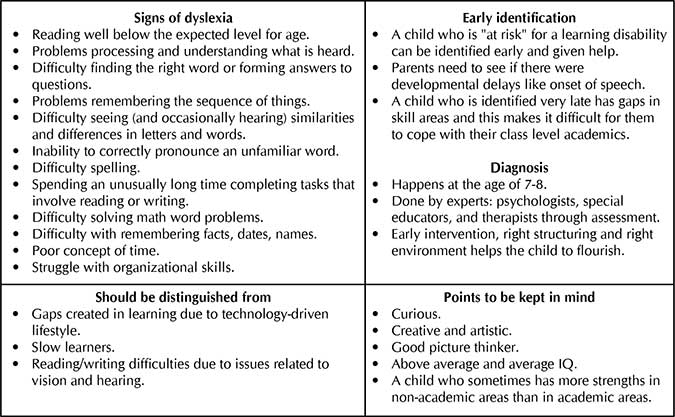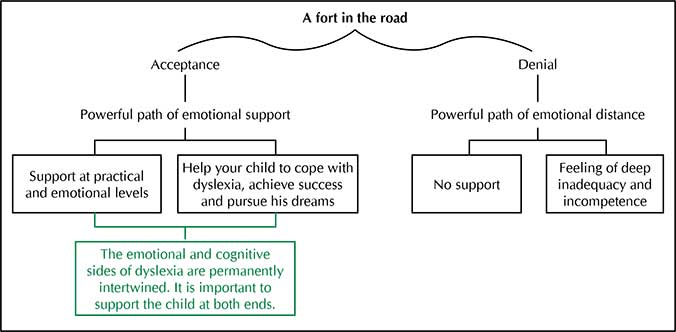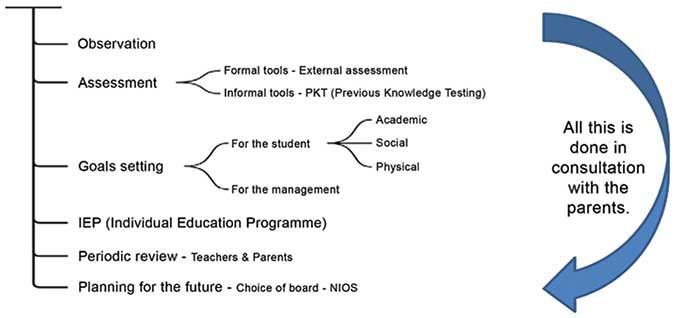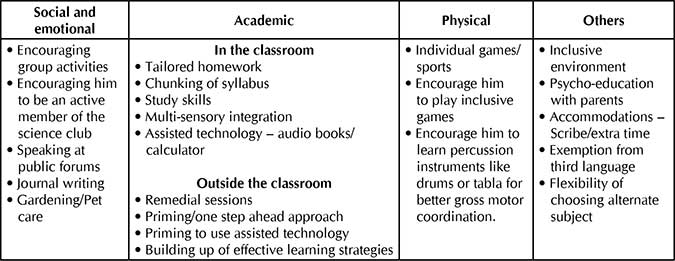Kalpana Sharma
In the two decades that I have worked as a teacher, I have always enjoyed being with children. A u-turn came in my life when I started raising my younger child. I found my son struggling at every end. Even at age seven, he was different from other children – he struggled to follow instructions, couldn’t remember names, even of colours, was unable to express himself, and was cranky most of the time. This resulted in a very low self-esteem and a reluctance to go to school.
I could sense a deep pain driven by frustration, isolation, and fear in him, which he was unable to express. Wanting to help, I attempted to plunge into the field of special education to understand him better. I met several people including children, teachers, and experts to understand his problem. I discovered that it was not just my child but several others, who were struggling with specific learning disabilities – largely dyslexia. Each child, teacher, and parent had something similar to share about the ‘secret life’ and agony their child was experiencing, some of which I would like to recount here.

What does it feel like?
Reactions of others
Be in the wrong place – Try going to a wrong exit/entry at an important event that is time bound. Face the reaction.
Ask for help after annoying a person – annoy a person and then ask for help for a silly thing. Face the reaction.
Struggle with language
Try listing some complex names and then attempt to find their spellings and correct pronunciation and usage. A dyslexic child struggles with this often.
Take a foreign language class
A severely dyslexic child is unable to follow the language in the class and struggles to make sense.
Writing difficulties
Try writing with your left hand if you are right-handed. Feel the pain and stress. A dyslexic child goes through this often.
Understanding the dyslexic child
Dyslexia is ‘invisible’. It has no overt signs to help you differentiate one child from another in the context of learning disability. This is why a dyslexic child, who looks like any other child, has so much going on inside that needs to be understood if we need to reach out to them.
What is dyslexia?
As a parent and as an educator, I have approached dyslexia from the perspective of children’s experiences. I observed that all dyslexic children demonstrate some difficulty with language skills, but this varies from child to child. Different children might have problems with reversal (reversing letters and numbers, such as 9 to 6, b to d), memory, or reading. Though children with dyslexia experience difficulties in processing the written language, they are often bright, creative, and talented individuals. Most have average to above average IQs. Dyslexia cannot be presented and should not be understood as black-and-white. This disability is far more complex.

Experiences of frustration
They take so much time
“I have a child in my class who struggles with writing. By the time the whole class has finished the entire worksheet, he manages to write just a single line. It appears as if he struggles with using the right words. His spellings are all over the place. He is unable to punctuate, leave aside grammar. His handwriting is sloppy and it is extremely difficult to make out what he has written. Every single day he spends extra time to cover up his written work and misses all the fun activities. My heart goes out to always having to detain him. I find him disorganized and forgetful.” – A teacher
Feeling of fear
Avoiding situations
“I have seen many children being crippled by fear. A sense of not fitting in the frame is a deep scar for them. Many exhibit a strong reluctance to go to school. Many avoid situations by giving excuses. I once had a child who just refused to go and play. It would really hurt me when this child would sit by herself while the whole school would be playing. On urging her further, she finally expressed that she had ‘zero flexibility’. This phrase just shook me. On probing further, she explained how out of the frame she feels.” – A teacher
Isolation
A sense of not fitting in
“My son had been so excited to be a part of hostel life. He had counted days to experience it. Finally, when the day arrived, his excitement faded. He struggled to fit in. Boys love to play and would spend most of their time doing so. The games appeared to be too complex for him. He felt aloof since he couldn’t think quickly, lacked fine coordination and verbal wit. A joke too appeared difficult for him to comprehend. He slowly moved away and it appeared as if he was trying to avoid embarrassment or fear.” – A parent
All these made me want to get to the bottom of this and unravel the problems these children were experiencing. It has been an intense journey to understand the needs of these diverse learners and to help them in the best possible way.
Detecting the signs of dyslexia
Most of the time, the early signs of dyslexia are caught by teachers; sometimes by parents. It so happens that the exuberant learner starts having problems with reading or writing, sometimes both. The child doesn’t appear to be his normal self. Parents and teachers see incomplete or shoddy work and a general drop in performance and interest. Overseeing homework or class work, parents and teachers may notice that the child is facing difficulties.
In case the signs continue to exist and start compounding, one should go in for an early diagnosis. The diagnosis helps as a guide map for early intervention.
After the diagnosis:

What can be done?
The Learning Resource Centre (LRC) – This was established at Rajghat Besant School in 2017. LRC is a whole school approach where we work together to support our diverse learners. It is a space which is equipped to meet the demands of the diverse learners. It is led by teachers who are trained to work with special needs children or are experts in remedial teaching. The center aims at creating an inclusive school approach by sensitizing children, parents, and students. LRC also looks into easing out the journey of the child by exploring various options of boards, concessions, and planning for the future of the child.
In case of absence of a structure like LRC, the school can follow the option of referring the child to special educators outside the school.

Case study
Lohitaksh (name changed) is a student of class 8. He has excellent observational skills. Lohitaksh struggles to make friends and often ends up fighting with his classmates. He is not swift as he doesn’t have a well-coordinated body. He often struggles to be a part of group activities and spends most of his time alone. He is unable to focus in class for a long time and speaks out of turn or starts doing weird things in class. All this disturbs the class flow. His understanding of concepts being taught is below the minimum learning level. He also shrugs from written work and is unable to take responsibility of his belongings. His father is into business and mother is a homemaker. Both parents are aware of their child’s problem at the surface level.
Lohitaksh joined Rajghat Besant School in class 4. He had excellent observation, was curious, loved doing science experiments and listening to stories. He was restless, fidgety, hyperactive, disrupted the class, and had issues mixing with friends. Lohitaksh shrugged away from reading and writing. He had serious writing issues and was unable to hold a pencil. In order to figure a way out to help the child, we worked out an assessment plan. Informal tools – comprehensive feedback from current and previous teachers was taken. This included all aspects of the child – academic, emotional, and physical. Parents were also met and inputs were taken from them. PKT (Previous Knowledge Testing) was done to understand the current academic level of the child. This helped in creating a comprehensive profile of Lohitaksh – strengths, needs, and current academic levels. It was felt that this was not enough and thereafter formal tools were used for assessment. He was sent out for an external assessment with a comprehensive school report stating his current level, interventions being done and problems being faced. The formal assessment done outside the school by experts (psychologists, special educators, therapists) stated that he had Specific Learning Disability – dyslexia, dyscalculia with ADHD (Attention Deficit Hyperactivity Disorder). Few suggestions and concessions were also stated which acted as a guide map for the school and parents to work with the child.
| Examination boards like the State Board, CBSE, ICSE, IGCSE, NIOS do provide concessions during board exams. The school must make the parents aware of this. Many a times, NIOS helps such children to work at their own pace with the facility for staggered exams. The following links can help you explore more about the liberal approach of the boards. https://www.mdachennai.com/dyslexia/board-concessions https://www.nios.ac.in/media/documents/PWD/provisionforlwd.pdf |
Recommendations by experts
• Psycho-education with the parents regarding his current functioning and difficulties faced so that the pressure and expectations are reality based.
• Positive environment at home and support of family members to maintain and strengthen positive behaviour.
• Consistent and graded reinforcement to increase the motivation of the child to help him deal with academic work.
• Structured study schedule, time management and effective study skills along with strategy building to help him deal with the academic demands. Use of different study techniques like breaking the task into chunks, elaborative rehearsal instead of rote learning, mnemonics, etc., should be promoted and he should be motivated to develop effective learning strategies.
• Chunking of syllabus – Forest to tree approach – under this approach, we give an overview of the entire chapter to the child but do not expect the child to know the detail of every tree (sub-themes). We can skip some parts that are abstract, or are difficult due to dates, scientific terms, complex procedures, etc.
• Colour coding, pictorial representation along with multisensory integration to help him in retention and recall of the concepts taught.
• He is likely to benefit from remedial education and so regular follow up with the special educator is advised.
• He would benefit from individual attention within the classroom setting, such as reminders to finish class work, seating him in front of the teacher, however away from windows or doors, and appreciating him for efforts in all areas of functioning. Using a ruler to help kids read in a straight line. Have L shaped cards – these cards help to frame sections of textbook pages and help focus their section.
• Follow-up with the Child Guidance Team (led by the school counsellor for uplifting the social-emotional wellbeing of the child) for further intervention.
Concessions
• Extra time/scribe during examination will help the child give a better performance.
• Assignments and examination papers should be marked for content and ideas while ignoring handwriting and spelling mistakes.
• Exemption from third language may be considered.
• Facility of choosing alternate subjects as per the guidelines of the board can be considered.
• Use of calculator can be allowed as per guidelines.
Once the assessment and PKT were in place we were able to chalk out an Individual Education Program for Lohitaksh. This required setting of achievable and measurable goals for various areas. While creating an IEP, it is essential to sketch out a comprehensive view of the child, which is a combination of his strengths, areas of struggle (academically), and current social and emotional levels.

Goals were set for the term and monthly review helped us relook the IEP. All associated teachers met and shared feedback to understand the progress of the child. This is a process which goes on and requires setting fresh goals once the previous ones have been achieved. After several years of work, Lohitaksh is flowering. His parents seem to have understood the importance of giving a rhythm to his life. They did not prohibit him from doing a fun activity as punishment for poor academic success. Enough opportunities were created at the school and home to explore and pursue passions and interests which acted as a necessary counterbalance to academic challenges. Lohitaksh today enjoys playing not only individual sports but also team games. His excellent observational skills have helped him appreciate birds. He loves bird watching. He is also slowly learning photography and is comfortable playing a few musical instruments. The concessions granted by the board have helped us in making learning more joyful for him. He is able to work at his own pace. Use of assisted technology, calculator, extra time, scribe have helped wean away the academic pressure of procedural skills and focus more on conceptual understanding of the subjects. In his journey of self-discovery, two goals had to go hand in hand – first, helping him discover his unknown strengths, which was the ultimate booster of his self-confidence, and second bolstering a sense of achievement as far as his academic performance, parents, and teachers were concerned. All this has helped in creating a nourishing environment for Lohitaksh where he is welcomed with heartfelt attention. This inclusion has been an opportunity to learn together and from one another. It is a delight to see this intelligent and thinking person blossom.
Conclusion
An involved and intensive attention, coordination, and collaboration between teachers and parents could lead to positive outcomes with dyslexic children’s emotional wellbeing and academic performance.
Krishnamurti has rightly said that it’s much easier to condemn a child than to understand a child. Understanding takes time, effort, patience and sustained, heartful attention. Condemnation is quick and conditioned. Over these years, it has been a transformative educational experience for me to see many of my diverse learners in totality, and not in a fragmented manner.
Dyslexic children find themselves in an esoteric world of their own. They are yearning to be understood, appreciated, and empathized with. They too want to feel normal. For us it can be a joy to connect with such beautiful souls. May we discover this joy!
The author has taught for more than two decades in different places and grades. Her experience with under resourced schools and educational colleges makes her realize that we need to work with children to address their different learning needs, especially at school. She teaches English and has deep interest in inclusive education. She is currently working as Junior School Headmistress at Rajghat Besant School. She can be reached at Kalpana.sharma@rajghatbesantschool.org.
